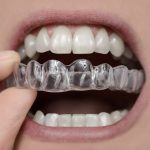Do you grind your teeth at night? You may be suffering from bruxism, a condition that can lead to tooth erosion and jaw pain.
The experts at Clinique MFML explain what bruxism is, what causes it, how to treat it and how to prevent it.
What is bruxism?
Bruxism, , is a condition that affects a large portion of the Canadian population and results in unconscious jaw clenching and grinding of the teeth, causing them to wear down. It can occur both during the day and at night, although it is most common during sleep.
Most of the time, the person affected is unaware that he or she has bruxism.
Bruxism usually appears at an early age (usually in adolescence) and affects both men and women. Moreover, it is a very harmful habit that, depending on how often it occurs, can cause extreme wear and tear and pain in the jaw muscles and temporomandibular joint.
What causes bruxism?
While there are many different theories about the possible causes of bruxism, the actual cause of this dental health problem remains unknown. Many experts agree that stress and sleep disturbances may be two of the main causes of this condition, although they also consider other factors that may be involved in the onset of bruxism such as:
- Misalignment of teeth or jaws, which may require orthognathic surgery
- Breathing problems during sleep, such as sleep apnea
- Anxiety
What are the symptoms of bruxism?
In addition to tooth hypersensitivity and constant pain in the facial muscles and teeth, bruxism can cause other symptoms such as:
- Pain or tightness in the temporal areas or lower jaw upon awakening.
- Tooth sensitivity. Especially to cold, heat and sweet foods.
- A pain often described as crampy, sometimes radiating to the neck, cheeks, preauricular area and temples.
- Pain in other areas of the body. Discomfort can spread to other organs and cause pain in the neck, ears or head.
- Insomnia. The discomfort produced by the pain can lead to trouble falling asleep.
- Grinding noise, reported by spouse or other family member.
When the problem of bruxism is not corrected early on, it often leads to pathologies or joint disorders and disjunction of the jaws that can produce trismus (a symptom that makes it difficult or restricts the proper opening of the mouth) and can even lead to very painful muscle contractures.
What are the treatments for bruxism?
Treatments for bruxism are mainly aimed at reducing teeth grinding, preventing enamel wear, eliminating pain, reducing anxiety and avoiding possible permanent damage to the jaw. Although orthognathic surgery may be necessary in specific cases, there are generally two types of treatment.
Occlusal plate for bruxism
In most cases, especially in cases of nocturnal bruxism, the specialist recommends that the patient use an occlusal plate. This is an acrylic plate adapted to the patient’s teeth, which must be put in place during sleeping hours, and whose function is to place the mandible in a neutral position, the goal being to relax the muscles of mastication and to decrease the pressure on the temporomandibular joint and finally to prevent tooth to tooth contact and thus the premature wear that results.
Prosthetic rehabilitation for bruxism
In more advanced cases of bruxism in which there is significant wear of the teeth and a reduction in the vertical dimension that affects the temporomandibular joint, prosthetic rehabilitation of the teeth is recommended to restore the optimal position of the joint.
Treat bruxism to maintain good oral health
Bruxism is a disorder that can ultimately affect your oral health. However, with proper treatment, it is possible to reduce its harmful effects on your teeth and chewing apparatus.




